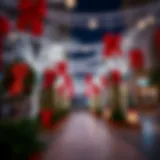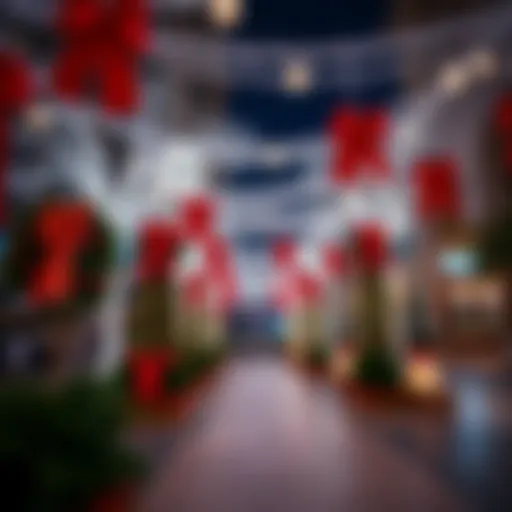Discovering Souq Naif: A Treasure in Dubai's Markets
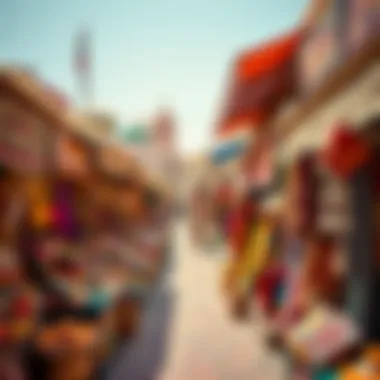
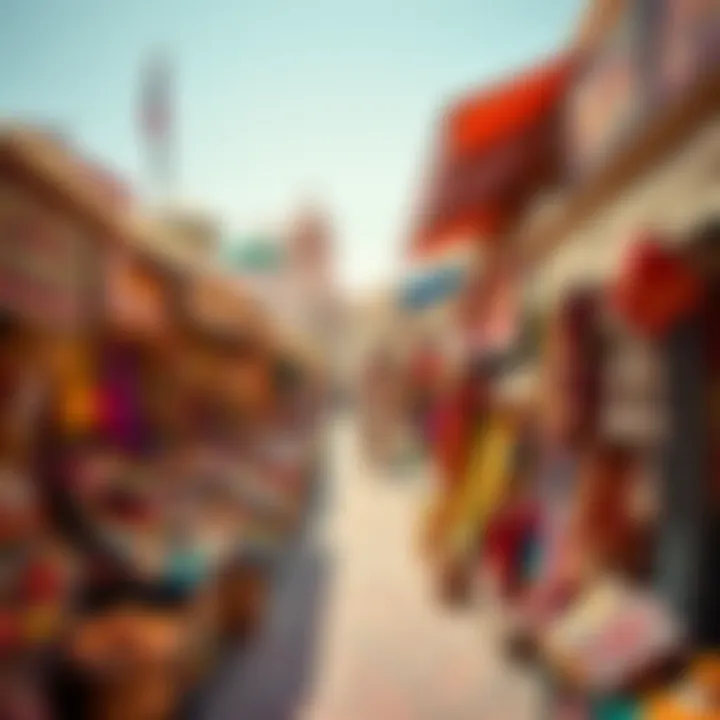
Intro
Dubai, a city known for its undeniable opulence, seems to increasingly embrace the notion of heritage while racing towards modernity. Amidst the towering skyscrapers and the glitzy malls, Souq Naif stands as a testament to the relentless spirit of traditional markets in the region. Walking through its lively alleys is like taking a step back in time, where every corner holds stories and the scent of spices wafts through the air, inviting visitors to indulge their senses.
In a place bustling with tourists and locals alike, one might wonder, what sets Souq Naif apart from the other marketplaces? This article unpacks the layers of significance Souq Naif has in Dubai's vibrant cultural tapestry. More than just a shopping destination, it plays an integral role in the local economy and offers a unique experience underlined with a rich historical context.
We will examine various aspects of the souq, covering its historical roots, the diverse range of goods available, and its evolving role in a city characterized by rapid modernization. Additionally, we aim to provide a nuanced understanding of what makes Souq Naif so appealing for both residents and visitors, with insights that reach beyond the act of mere commerce.
To truly grasp the heart of Souq Naif, one must appreciate not only the things one can buy but the cultural significance, the community interactions, and the authentic hustle and bustle this market embodies. So, let’s delve deeper into the experiences awaiting you in this cornerstone of Dubai's heritage.
Prelude to Souq Naif
Souq Naif serves as a window into Dubai's rich past and dynamic present, blending the heartbeat of traditional commerce with the pulse of a modern city. Nestled in the heart of the city, this market is more than just a shopping destination; it embodies the essence of community and culture that has shaped Dubai over the years. Visitors often find themselves wandering through its vibrant alleyways, where each corner tells a story of resilience and tradition.
Historical Background
The roots of Souq Naif stretch back to the days when Dubai was a modest fishing village. Originally, it was a gathering space for traders and merchants long before globalization took hold. Established during the late 19th century, the souq has undergone several transformations yet retained its essence as a hub of trade. It has catered to diverse merchants, from pearl divers to spice traders, showcasing various goods that reflect the region's rich heritage.
Over the years, as Dubai evolved into a bustling metropolis, Souq Naif preserved its historical significance, attracting both locals and tourists. Each item on display in its shops carries the weight of history, invoking nostalgia and a sense of belonging among its visitors.
Cultural Significance
Souq Naif isn't just a market; it represents the heart of Emirati culture. The bustling atmosphere pulsates with the sounds of bargaining, fragrant spices, and the vibrant colors of textiles. It offers a space where traditional Arabic hospitality shines through, with shopkeepers often inviting customers to share a cup of Arabic coffee as they browse.
From handcrafted souvenirs to authentic textiles, the souq showcases the craftsmanship of local artisans. These products are not merely for sale; they hold stories that resonate with the local populace, emphasizing the importance of preserving traditional practices amid modern advancements.
The souq plays a vital role in community life, not just as a commercial center but also as a meeting point for families and friends. Many festivals and cultural events take place here, drawing people together to celebrate their heritage while nurturing relationships within the community. It serves as a reminder that amid Dubai's rapid development, there remains a place for its rich traditions to thrive.
This vibrant market transcends commerce, embodying the spirit of unity and cultural pride in a rapidly changing landscape.
Architectural Features of Souq Naif
Understanding the architectural features of Souq Naif is essential to grasping its essence. These elements not only define the physical structure of the market but also embody the cultural and historical spirit of Dubai. The interplay between traditional and modern design speaks volumes about how this market has evolved while remaining rooted in its heritage.
Whether you're an investor, a homebuyer, or simply a curious visitor, observing these architectural traits can enhance your appreciation of this bustling souq. It will help you understand the balance struck between maintaining one’s identity and embracing progress in a rapidly changing urban landscape.
Traditional Design Elements
The traditional design elements of Souq Naif convey a rich narrative of the local culture and legacy. From the moment one steps into the market, the charm of its layout becomes evident.
- Wind Towers: These architectural features, known as barjeel, play an essential role in natural ventilation, a necessity in the balmy Dubai climate. The wind towers direct cool breezes into the stalls, offering welcome relief to both shoppers and vendors.
- Arched Entrances: You’ll notice the classic archways that adorn the entrances and pathways. These arches are not just for aesthetics; they also serve a practical purpose by creating shaded areas, which help keep the temperatures lower.
- Use of Natural Materials: Traditional buildings in Souq Naif commonly feature materials like coral stones and wood, reflecting the resources that were readily available. The intricate wooden latticework, or mashrabiya, adds an artistic flair while providing privacy and ventilation.
- Marketplace Layout: The arrangement of stalls and shops within the souq is very organic and allows for easy navigation. The covered walkways bring a uniqueness to the shopping experience, encouraging leisurely strolls. This environment nurtures interactions between merchants and patrons, which is a cornerstone of the market culture.
These traditional elements do more than beautify the space; they instill a sense of history and remind visitors of the past, of how trade once flourished in these cultural hubs long before the rise of modern malls.
Modern Enhancements
As Dubai strides into the future, Souq Naif integrates modern enhancements without overshadowing its traditional roots. These upgrades are strategically incorporated to boost functionality while preserving the authentic ambience of the market.
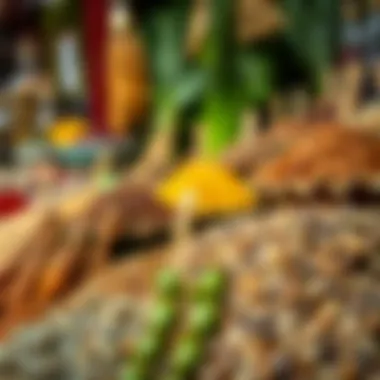
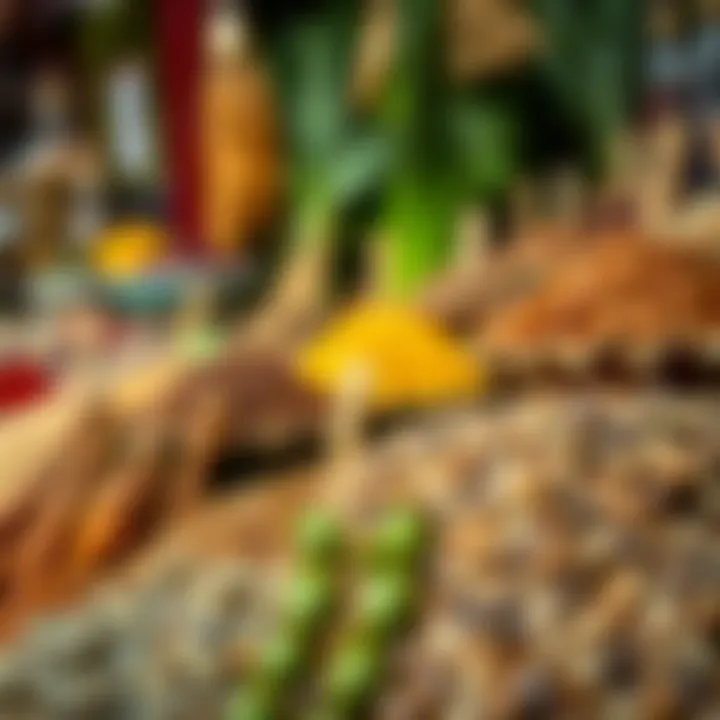
- Enhanced Lighting: Improved lighting fixtures have been installed to illuminate the pathways and stalls better. By striking a balance between aesthetics and practicality, the enhancements ensure safety for evening visitors while showcasing products more attractively.
- Digital Signage: Some merchants have adopted digital displays for menu boards and product listings. It may seem a small touch, but this modern twist aids in improving customer service and provides an efficient means of communication in a bustling environment.
- Accessibility Features: Features such as ramps and wider pathways have been introduced, ensuring that the market is accessible to everyone. This includes shops designed to accommodate wheelchair users, making the souq more inclusive.
- Sustainable Practices: Initiatives aimed at minimizing waste and promoting sustainability have been adopted. This can be seen in practices like using reusable bags for shopping instead of plastic ones, speaking to a more eco-conscious approach to commerce.
Souq Naif stands as a testament to how effective modernization can be when executed thoughtfully. By embracing both the old and the new, it cultivates a unique experience that enriches both locals and visitors alike, allowing them to connect with the vibrant history of Dubai while enjoying contemporary conveniences.
"Souq Naif is more than just a shopping destination; it is a living museum of Dubai’s architectural heritage blended with the pulse of modern life."
In essence, the architectural features of Souq Naif are not merely structures—each facet tells a story, linking the past to the present while setting the stage for the future.
Goods and Services at Souq Naif
The offerings at Souq Naif are more than just a collection of goods; they reflect the rich tapestry of Dubai’s history and culture. As one of the oldest markets in the city, it hosts a plethora of products that cater to both the local population and the throngs of tourists who traverse its winding paths. This section dives into the various types of goods and services available, demonstrating their significance in the broader narrative of Dubai's enduring cultural landscape.
Textiles and Clothing
When you step into the textile section of Souq Naif, it feels like walking into a vibrant painting. Stacks of colorful fabrics greet you, from soft silks to sturdy cottons, often woven with intricate patterns that tell stories of age-old traditions. You can find everything here, from contemporary clothing to traditional attire like abayas and kanduras. The local vendors are not merely salespeople; they are storytellers, weaving tales of regional styles and trends into their sales pitches.
For those with an eye for unique fashion statements, hunting through this section can be a truly rewarding experience. You might stumble upon hand-embroidered shawls or locally designed t-shirts that are not easily found elsewhere. One can also find some custom tailoring services here—making it easy to get perfectly fitted garments without the steep price tags of high-end boutiques.
Handicrafts and Souvenirs
Handicrafts embody the artistic spirit of the region, and Souq Naif showcases a delightful collection. From delicate pottery to beautiful wooden carvings, each item is a testament to the skill of local artisans. Unlike mass-produced goods, these creations hold stories of heritage and craftsmanship.
When one wanders through the handicraft stalls, there’s an unmistakable charm in buying a piece that supports local creators. Many visitors often leave with unique souvenirs such as traditional Arabic coffee pots or handwoven baskets, which serve as a piece of Dubai to take back home. These items not only make fantastic conversation starters but also reflect the beauty of authentic Emirati culture.
Traditional Spices and Foods
The aromas wafting through the spice section of Souq Naif instantly transport you to a different realm. From the pungent scent of saffron to the warm notes of cardamom, this section can tantalize anyone's senses. Local spice vendors, usually equipped with deep knowledge, are more than eager to share their secrets and stories about their products.
Many shoppers find that these authentic spices are fresher than what’s available in typical supermarkets. You can also snag a selection of traditional foods, including dates stuffed with nuts, which make for great gifts or personal treats. Lining up for a taste of freshly prepared local delicacies is part of the experience, where even curious tourists might try their hand at local cuisine.
“Souq Naif is not just a market; it's where the heart of culture beats strong through textiles, crafts, and spices.”
In summary, the goods and services available in Souq Naif enrich the experience of both tourists and locals. They provide a tactile connection to Dubai’s history and contemporary life. By engaging with local vendors and exploring the vibrant selection of textiles, handicrafts, and spices, visitors truly uncover the essence of what makes this market a vital part of the city.
The Shopping Experience
The shopping experience at Souq Naif is a tapestry woven from various threads—tradition, culture, and community. It's not just about purchasing goods; it's an immersive journey where the essence of Dubai's heritage comes alive. Visitors find themselves walking amidst colorful stalls, chatting with merchants, and sampling local delicacies. This vibrant atmosphere is not only a joy for senses but also a heartwarming invitation to engage in the community's rich traditions.
Bargaining Traditions
Bargaining is more than just a practice at Souq Naif; it's an art form with deep cultural roots. In this arena, haggling transforms from mere negotiation to a social dance, where both buyer and seller engage in a playful back-and-forth. Typically, when a visitor expresses interest in an item, the seller often quotes a price that is higher than what they are willing to receive. This initiates a cycle of negotiation, creating a lively and enjoyable atmosphere. It’s not just about saving a few dirhams; it’s about the experience itself.
- Understand the Norms: To effectively participate in this tradition, familiarize yourself with local customs. For example, a polite smile and respectful demeanor can go a long way.
- Know Your Limits: Before stepping into the fray, decide how much you’re willing to pay. This will help during the back-and-forth exchanges.
- Enjoy the Process: The aim isn't solely to achieve the lowest price but to enjoy the interaction. Engaging in a friendly banter can often lead to better deals, as sellers appreciate customers who are genuinely interested.
Overall, the negotiations are an essential part of the market's charm, providing insight into local cultural practices while simultaneously enhancing the visitor's connection to the place.
Customer Interactions
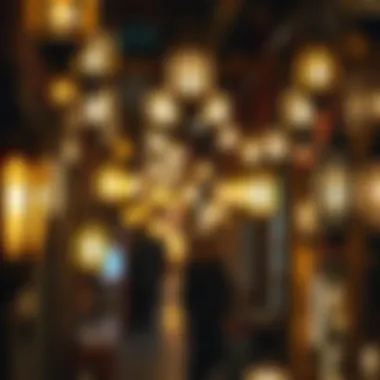
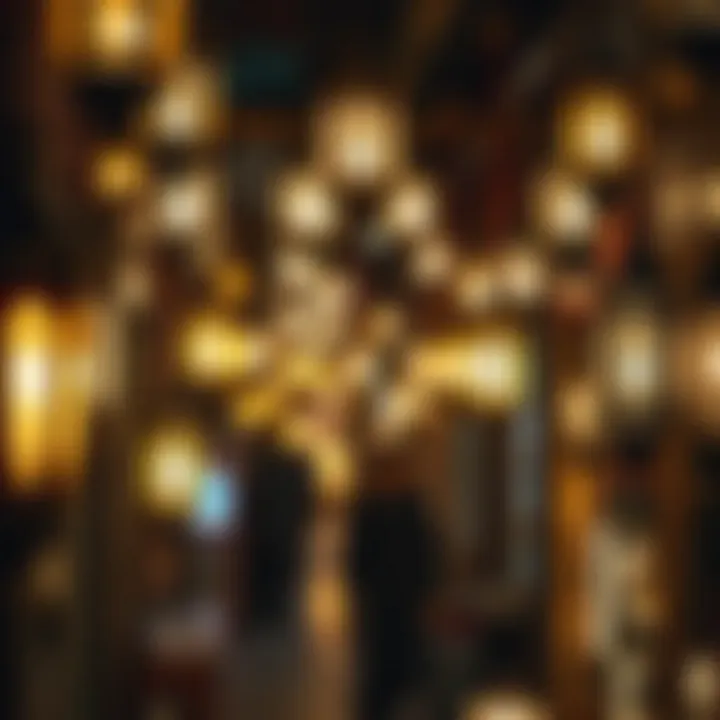
Interacting with vendors at Souq Naif unfolds layers of cultural joy. Each merchant typically has a story to share, making the shopping experience richer and more informative. Immersed in this setting, customers often find they are not just buyers but participants in a larger conversation about culture, tradition, and history.
- Storytelling: Many vendors have lived through the evolution of the souq. Their narratives, steeped in personal experience, can greatly enrich your understanding of local customs and traditions.
- Building Connections: Frequent visitors often develop rapport with sellers. Such relationships can lead to personalized recommendations or special deals on products, transforming an ordinary transaction into a lasting friendship.
- Culinary Delights: The souq isn’t solely about crafts and textiles; it also offers a stunning array of culinary options. Interactions here can lead to delightful discoveries, from sampling fragrant spices to tasting freshly prepared traditional dishes.
As one wanders through the bustling passageways, it's easy to appreciate that these interactions are what truly differentiate Souq Naif from modern shopping malls. It’s a place where you not only acquire goods but also memories and friendships, making every visit feel like a touch of home.
"In the heart of the souq, every shouted price and friendly laugh weaves a story that embodies the spirit of Dubai."
For those visiting or settling in Dubai, the shopping experience at Souq Naif transcends beyond mere transactions to create a colorful mosaic of interaction and community that is hard to replicate elsewhere.
By embracing this vibrant atmosphere, one can truly appreciate the cultural heart of Dubai.
Events and Festivals at Souq Naif
The lively atmosphere at Souq Naif takes on an even more vibrant character during various events and festivals throughout the year. These occasions not only enliven the souq but also pull in a diverse crowd, making it an essential layer of Dubai's cultural tapestry. It’s these events where tradition meets modernity, attracting locals and tourists alike. Each festival or seasonal event sets a stage for the market to display its rich heritage and engage visitors deeply with the community.
Cultural Festivals
Cultural festivals at Souq Naif serve as celebrations of the Emirate's rich traditions and attract visitors to experience Dubai's vibrant cultural scene. One noteworthy festival is the annual Dubai Shopping Festival. This event transforms the souq into a hub of activity, featuring traditional music performances, folkloric dances, and showcases of local artisans at work. Visitors can see firsthand how age-old crafts are not just preserved but also celebrated.
During cultural festivals, the souq's stalls often showcase crafts that tell stories of the past. Think intricately woven textiles or carefully handcrafted pottery. It's not just about shopping; it’s a moment when one can engage with the artisans, learning the stories behind their crafts.
Festivals here often include interactive workshops, allowing participants of all ages to immerse in the art of Arabic calligraphy, pottery, or traditional dance. This involvement adds a layer of authenticity rarely found in conventional markets.
“Cultural festivals are a living expression of the community's heart, reflecting not just goods but the very soul of Dubai.”
Seasonal Events
As seasons shift, so do the festivities at Souq Naif. Seasonal events bring about themes that reflect the local climate and culture. For instance, during Ramadan, the souq is adorned with beautiful lanterns, creating a captivating ambience. Special evening markets sprung up during this holy month, featuring local delicacies and offering vibrant evenings filled with social gatherings. There's a certain warmth to the experience—families gather, and friends come together, reflecting the spirit of unity emphasized during Ramadan.
During the summer months, the souq hosts various culinary events. These festvials might showcase a
Souq Naif in the Context of Dubai's Economy
Dubai's economy is a complex tapestry woven from many strands, and Souq Naif holds a unique place in this vibrant narrative. It is not just a market; it's a slice of Dubai's cultural and economic ecosystem. The souq's significance transcends traditional commerce and takes on various roles that contribute to the sophistication and multicultural identity of the emirate.
At its core, Souq Naif plays an essential role in the local economy by serving as both a commercial hub and a community gathering place. By providing a venue for small businesses and local artisans, it nurtures entrepreneurship and fosters economic diversity. This may sound a bit dry, but the energy in the air when you step into the souq tells a different story. The hustle and bustle of vendors, the smell of spices, and the colorful display of textiles make it a dynamic site for economic activity.
Role in Local Economy
The local economy benefits from Souq Naif in several ways. Vendors, often family-owned or small enterprises, contribute directly to the economic landscape by offering unique products and personalized service, which large retail chains cannot replicate. Jobs are created—for every shop, there are assistants, cashiers, and sometimes even family members involved in the daily grind. Each transaction represents not just a commercial exchange but a vital link in the community’s overall economic health.
Additionally, Souq Naif serves as a launchpad for new entrepreneurs. Many locals begin their business journey with a small stall or shop in the souq, allowing them to test the waters before diving into larger investments. This fosters a spirit of innovation and resilience, which is essential in a rapidly changing economic landscape like Dubai's.
- Increased foot traffic supports nearby businesses, from cafes to hotels, creating a symbiotic relationship that benefits everyone.
- Tourists flock to the area, eager to experience the authentic charm of traditional marketplaces, leading to higher consumer spending in the vicinity.
Impact of Tourism
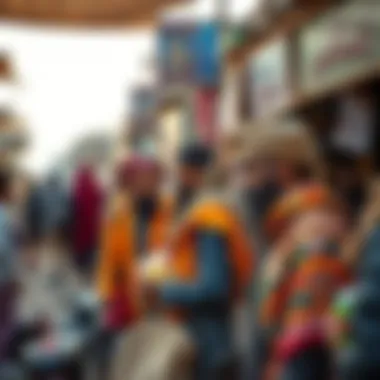
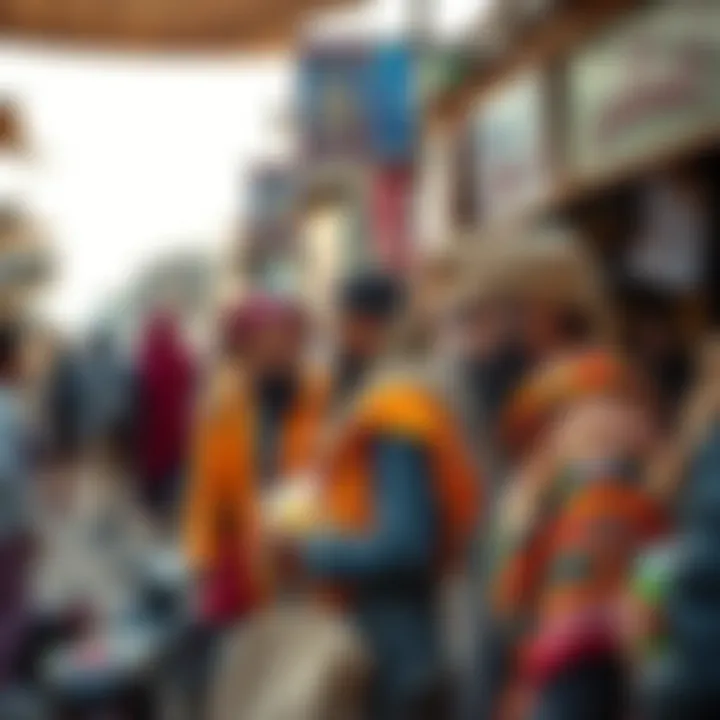
Tourism is a double-edged sword, and in the case of Souq Naif, it has largely been a boon. The market is a cornerstone of Dubai’s cultural tourism strategy, showcasing authentic Emirati culture and commerce. Visitors come not just to shop but also to experience a vibrant slice of life where tradition meets modernity. According to observations, tourists often spend on items that reflect the region’s rich heritage, from handcrafted souvenirs to exotic spices, thus injecting life into the local economy.
"Souq Naif is one of those rare places where you can touch history while filling your shopping bags."
It is also worth noting that the influx of international visitors creates opportunities for cultural exchange, enriching both the tourists' experience and the local community. Staff and vendors at Souq Naif often share stories, customs, and insights into Emirati culture, deepening the understanding of Dubai's rich heritage.
While the market retains its traditional charm, it has adapted to cater to the diverse clientele that visits, signaling its importance not just as a local marketplace but as a mainstay in Dubai's broader tourism framework. The continued growth of awareness around cultural tourism strengthens its positioning as an economic asset.
In summary, Souq Naif is much more than a shopping venue. It's a vital cog in Dubai's economic machine, offering a blend of community, entrepreneurship, and cultural tourism. As Dubai continues to evolve, the souq stands as a reminder of the emirate's rich past while embodying its endless possibilities.
Visitor Guidelines
Understanding the ins and outs of Souq Naif enhances the experience for both newcomers and seasoned visitors alike. This section is crafted to provide valuable insights, ensuring every trip to this vibrant market is not just about shopping but also about immersing oneself in its rich fabric of culture and community. Knowing when to visit, how to get there, and how to navigate safely makes a world of difference. Here, we will explore the best times to visit, essential transportation tips, and key safety considerations that can help you enjoy your time at Souq Naif to the fullest.
Best Times to Visit
Timing can be everything at Souq Naif. While the market is alive with visitors throughout the day, certain times offer a more pleasant experience, especially for those looking to soak in the atmosphere without the hustle and bustle. Here are a few recommendations:
- Early Mornings: Arriving right when the market opens can provide a quieter experience. The air is cooler, and the stalls are freshly stocked, making it perfect for leisurely browsing.
- Late Afternoons: As temperatures cool in the evening, Souq Naif becomes busier. The vibrant ambiance, complete with local flavors wafting through the air, creates a lively scene.
- Weekends and Holidays: Expect a bustling crowd, as locals and tourists alike flock to the market. Events and festivals often take place during these periods, adding rich layers to your visit.
"Exploring the souq at different times reveals its dynamic personality, shifting from tranquil to lively, each with its own charm."
Transportation Tips
Getting to Souq Naif is fairly straightforward, thanks to its central location in Dubai. Here are some transportation choices:
- Metro: The Dubai Metro offers a cost-effective and efficient means of reaching the souq. The nearest station, Al Ras, lands you just a stone's throw away.
- Taxis and Ride-Sharing Apps: For convenience, cabs are readily available and are a comfortable way to travel, especially if you're carrying shopping bags. Ride-sharing services like Uber are also operational
- Walking: If you're staying nearby, don’t overlook the simple pleasure of a walk. The sights and sounds of Dubai’s streets can provide an enriching context to the journey.
Safety Considerations
While Souq Naif is generally safe, common-sense practices can enhance safety and enjoyment throughout your visit. Keep these in mind:
- Awareness of Crowds: Busy areas can attract pickpockets. Stay mindful of your personal items and keep bags close.
- Hydration and Sun Protection: Dubai's sun can be relentless. Drink plenty of water and wear hats or sunscreen, especially when roaming outdoors.
- Respect Local Customs: Understanding and appreciating local traditions not only keeps you safe but also enriches your experience. Dress modestly and be considerate in your interactions.
By laying down a solid foundation through this guide, visitors can embark on a memorable adventure in Souq Naif, absorbing all it has to offer while navigating with ease.
Future of Souq Naif
As Dubai continues its march toward modernization, one can't help but wonder what lies ahead for Souq Naif, the beating heart of the city’s traditional markets. The souq has been a cornerstone of local culture, linking generations and preserving traditions. However, the pressures of a rapidly evolving urban landscape pose both challenges and possibilities that could alter its very fabric.
Challenges of Modernization
The challenges presented by modernization are as diverse as they are daunting. As high-rises shoot up and luxury malls pop open their doors across the emirate, Souq Naif risks losing its unique charm amidst the shiny allure of contemporary consumerism.
- Infrastructural Changes: With new developments, infrastructure around the souq may transform drastically. Street layouts might shift, leading to changes in foot traffic and access.
- Competitors: Modern shopping plazas like The Dubai Mall offer convenience and elegance with high-end brands, effortlessly attracting the younger demographic, which may impact footfall at Souq Naif.
- Cultural Dilution: There is concern that as modernization sweeps through, the cultural identity of the souq could be diluted. The essence of traditional markets, rich with local character and heritage, might fade amidst globalized trends.
"The heart of Dubai's traditional market can’t just be another cog in the machine; it needs to pulse with life and authenticity."
Addressing these challenges will require balancing progress with preservation, ensuring that Souq Naif remains a relevant and cherished fixture in Dubai.
Preservation of Heritage
Amidst modernization, preserving the heritage of Souq Naif is paramount. This isn’t merely an option; it’s a necessity for keeping the spirit of the souq alive for future generations.
- Community Engagement: Involving the local community in decision-making processes is crucial. By gathering insights and feedback from residents, businesses, and customers, the development plans can reflect both modern needs and traditional values.
- Cultural Events: Hosting cultural events that celebrate local craftsmanship, folk traditions, and culinary delights can enhance the souq's cultural atmosphere. These events not only attract visitors but also reaffirm community bonds.
- Sustainable Practices: Embracing sustainability adds another layer of heritage preservation. Using local materials for renovations and promoting eco-friendly practices can ensure that the market retains its authenticity while adapting to contemporary sensibilities.


